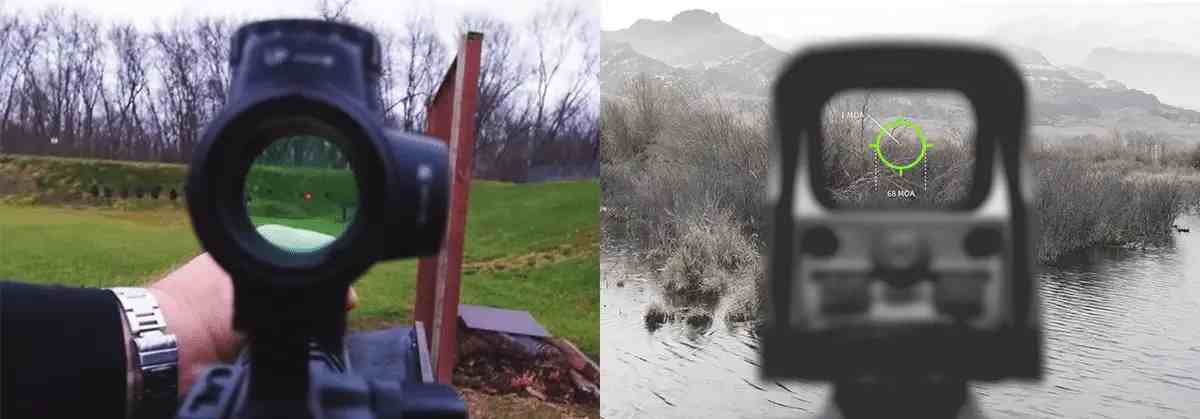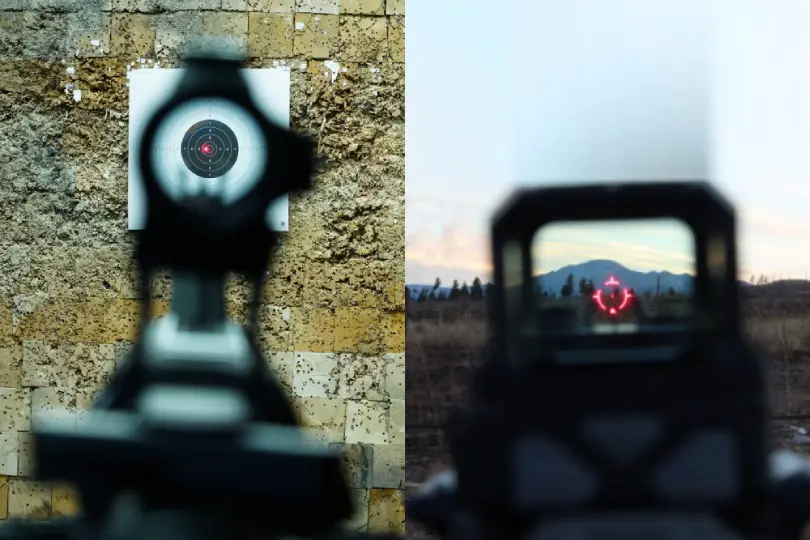Red dot and holographic sights are two of the most popular sighting systems today. Red dot sights provide a simple, easy-to-use aiming point without any magnification, while holographic sights offer more features and versatility.
But which one should you choose? In this article, we reveal the difference between red dot vs holographic sight so you can make an informed decision.
Let’s explore more in our in-depth “red dot sight vs holographic sight” comparison guide!
Red Dot vs Holographic Sights: Key Differences

There are many differences between a red dot and a holographic sight. However the key differences can be presented like this:
The key difference between red dots and holographic sights is the working principle and features. Red dots are cheaper and use a LED emitter to reflect the reticle into your eyes. On the other hand, slightly cost-effective holographic dots use a series of lasers and mirrors to create a hologram of the reticle.
Let’s explore the what else separates a red dot sight from a holographic one so you can use your sight to the fullest.
Technology
Red dot sights typically use LED emitters to project a reticle onto the coated lens of the sight.
On the other hand, holographic sights employ lasers and mirrors to create a 3D image of the reticle without relying on the front glass.
The reticle is superimposed over a specific target, no matter if the point of view of the shooter changes in a relative position to the sight while appearing in the exact same spot on target.
Both technologies provide an aiming point, but holographic optics are often more precise as they can give you a clearer sight picture.
Size and Weight
Red dots tend to be smaller, lighter, and more compact than holographic sights.
This makes them ideal for close-quarters shooting, as you can mount them on any gun without sacrificing maneuverability.
On the other hand, holographic sights tend to be larger and heavier due to the additional components required for their operation.
Holographic sights also tend to be heavier than red dot sights, making them less ideal for lightweight rifles and particular applications.
Color
Red dot sights typically have one or two reticle colors. For example, a standard red dot sight might feature both red and green reticles for improved visibility.
Holographic sights, however, offer a much wider range of reticle colors and patterns, allowing you to customize your sighting system for different situations.
Night Vision
Red dots aren’t night vision compatible, making them unsuitable for nighttime use.
On the contrary, holographic sights typically have built-in night vision compatibility, allowing you to use them with most kinds of night vision devices.
Reticle
Red dot sights feature a traditional reticle pattern like dots and crosshairs, while holographic sights offer a much larger window for target acquisition with multiple reticles to choose from.
With a holographic sight, the reticle is always on the spot. The projected reticle moves as you move the gun, but the aim remains at the same point.
It may seem trivial, but paying attention to your reticle when choosing is essential, as you’ll have to stare at it for a long time.
Battery Life & Power
Red dot sights typically have a much longer battery life than holographic sights, meaning you won’t have to replace or recharge your sight as often.
A red dot is always a helpful sight in power saving. The red dot uses the power-saving LED, while the holographic sight uses lasers for the holograms, draining the battery power much faster.
And this is the reason why the red dot can be used for up to 50,000 hours. Compared to this, holographic sights have only around 500-1000 hours of battery life.
Acquisition
Red dot sights are often easier and faster to acquire, as they require you to line up the reticle with your target instead of focusing on the target and then searching for the reticle.
Holographic sights, however, can be difficult to acquire if the reticle is too small or complicated.
Astigmatism (Vision Problem)
Having blurry vision (Astigmatism) is common in some people. They usually have trouble focusing on a red colored dot. The image becomes blurry for them.
Holographic sights work to ease the condition. It gives the user a clear field of view with a clear spot they can focus on.
Magnification
Magnification is always as important as getting the bull’s eye shot. The red dot and the holographic sights have magnifiers on the front.
The red dot contains a 2-MOA (Minute of Angle) focus dot, and the holographic only has a 1-MOA dot in the center. And this is the smallest light a human eye can see.
You can install any compatible magnifier with your red dot or holographic sight. If you place 3x magnifiers before your sights, the red dot MOA will become 6.
However, the Red dot are always at zero or one power, which means that they do not magnify. The sight is not meant for the precision shooting but it is for the close or the far shooting.
Durability
Both red dot and holographic sights are incredibly durable due to their construction materials (usually aluminum), but holographic sights are generally more robust due to the extra layers of protection.
Adjustable Features
Red dots can offer basic adjustable features like windage and elevation. They also offer
Adjustable brightness settings.
Holographic sights often have more features than Red Dot sight, such as reticles that can be adjusted for windage and elevation, enlarged viewing windows, magnifiers for increased accuracy at longer ranges, and more.
Price
In the sights, if you are tight on the budget, we suggest you buy the OK red dot for sub $50. But if you need better results, you must go with the sub- $200 range for better shots.
You’ll need to spend almost double or more for the best red dot.
You can also go with the holographic if you can spend more bucks, as the holographic sight is more expensive than the red dot, which starts from $400.
Holographic vs Red Dot Sights: Which One to Choose?
As you’re nearing the end of the holographic sight vs red dot debate, you should look for a concluding view of both sights in terms of their usability and performance.
A holographic sight is better in many aspects than the red dot, but they come at a much steeper price than the red one.
Maybe, you would keep these in mind while buying your red dot sight. So, if you are tight on the budget you must go with the red dot which will give you a lot in a low budget.
Mainly choosing the sight depends on the person who is using it. While using the electronic sights for the first time, you must go with the red dot. As the red dot is easy to handle and you might not be so fast to use the holographic. Also, as being a starter you will love to buy a bight for low price.
In case you have been using the red dot from a long time and like to upgrade, our recommendation will be the holographic sight.
A holographic sight will get you a bit faster with it and can shoot better around not 50 yeards or 100 yards, but 300 yards or more (with magnification)!
And with that, we’ve reached the end of our discussion for today. This guide provided an in-depth “Red Dot vs Holographic Sights” comparison so that you can choose the best one that fits you needs and budget. I hope the information proves to be helpful.
Thanks for reading this far. Feel free to share any thoughts and experiences you have with either one of theses dots in the comment section below. I wish you a great weekend ahead, and happy shooting!
FAQs
How Long Do Holographic Sights Last?
Ans: Generally speaking, a holographic sight lasts for about 5,000 to 6,000 rounds of ammunition. The life expectancy of holographic sights varies, depending on the manufacturer and materials used. The lenses should be kept clean and stored in a cool, dry place. Regular maintenance is also important.
Can You Magnify A Holographic Sight?
Ans: Yes, many holographic sights feature magnification capabilities, allowing you to zoom in on your target. The level of magnification depends on the model, but some can be up to four times more powerful than a non-magnified optic.
Does The Military Use Holographic Sights?
Ans: Yes, the military uses various types of holographic sights. However, the present US military uses EOTech holographic sights (The EOTech XPS3-2) under the brand name “Bushnell”. They holographic sights to increase accuracy, target acquisition speed and situational awareness in combats.









Leave a Comment